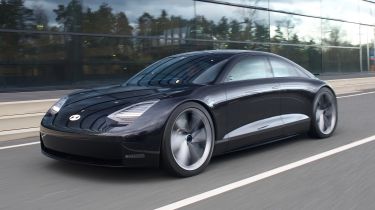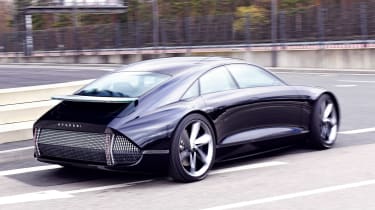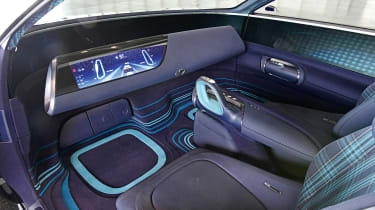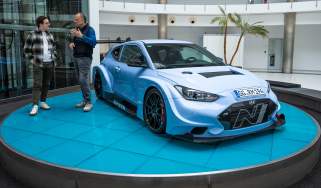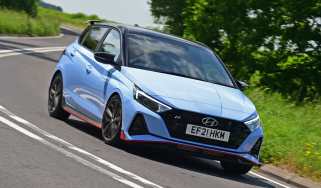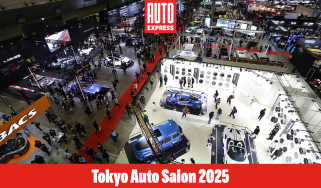New Hyundai Prophecy concept review
All-electric Hyundai Prophecy concept car previews a future where Hyundais have a more distinct look. We take a drive...
Ask Hyundai head designer Luc Donckerwolke to show you the company’s future, and he’ll point to this: the Prophecy. The concept introduces a new modular platform that will underpin a whole host of electric vehicles from both Hyundai and its sister brand Kia within the next few years. The platform is as significant to the Koreans as the MEB architecture is to the Volkswagen Group.
The concept’s grand unveiling was due to take place at March’s Geneva Motor Show, which for obvious reasons did not go ahead. But in order to take a closer look and learn more about the Prophecy, and Hyundai’s plans for it, Auto Express has been for an exclusive drive around the Nuremberg Messe, in Germany.
The ‘suicide’ doors open gracefully, allowing easy access to the cabin, where you can find a comfortable and slightly reclined position in the driver’s seat. Instead of the expected steering wheel, all there is a dashboard that’s littered with digital displays. The dash rotates at the touch of a button, and an additional slim shelf beneath the curved screen turns upright to reveal the fully digital instruments. Yet there’s still no steering wheel. In its place are two joystick-like handles, one mounted on the door, the other on the centre console.
While crawling around the big halls and figuring out how to steer the sleek, five-metre long show car with joysticks – which makes it feel like you’re in a video game rather than a car – we can’t help but be reminded of the handles of a vacuum cleaner. Perhaps it’s one area of the Prophecy that needs a design rethink.
Two things that remain conventional, however, are the pedals for accelerating and braking. Being a priceless concept, there’s little to be gathered from how the Prophecy actually drives at the low speeds we’re limited to; what’s important here is the radical new cabin.
There’s a nice balance between old and new inside; the digital hub of displays contrasts with the lovely blue and green tartan design that features on the doors and seats. One thing you won’t notice are the double-glazed windows, which do not open. Instead the Prophecy uses an air-filtration system, pumping clean air into and around the cabin when it detects increased levels of particulates inside, even when it’s charging. Clever.
The tartan theme is echoed in the back, where the absence of a B-pillar, the flat floor, and flush dashboard give the Prophecy a wonderfully airy feel inside.
Distinct designs for future Hyundais
Speaking exclusively to Auto Express, SangYup Lee, Hyundai Senior Vice President and Head of Hyundai Global Design Center. said; “The EV skateboard platform with the short overhang and cowl pulled forward enables us to stretch the cabin to provide more space inside,” Lee told us. “The Prophecy is a future sedan - but not a traditional type of sedan, it will have lots of space inside and more curvature so it means a lot.”
Lee also revealed that the new models would be the start of a new design philosophy in Hyundai that would avoid the ‘Russian Doll’ strategy employed by many other car makers.
“Our cars will be more like a chess board where you have a King, Queen, Bishop, Knight,” Lee told us. “They all look different and function differently but when they’re together they come as one team.This is what the Hyundai look is all about - diversifying our design to fulfil our customer’s lifestyle.
“People say that you have to have to default with the grille looking the same and headlights looking the same, but we want to challenge that consistency in detail. So the cars will look completely different.”
Although future Hyundai models will have different looks, Lee plans to use lighting technology to bring the brand's model family together. The Prophecy concept uses ‘pixel lamp lights’ – a series of tiny, square LED lights that can also be animated. “The family look will come from the lights,” said Lee. “We have consistency in detail - in the pixel graphic. It’s like a hidden charm that brings the consistency. The lamp is a functional part, but now the lamp is a design part - we continue our special story in the lamps."
Lee also spoke about the newly-announced collaboration between Hyundai and Los Angeles-based Canoo in co-developing a small electric vehicle platform for autonomous and urban electric vehicles. “That will be part of our design chess board,” he said.
What do you think of the Hyundai Prophecy? Let us know in the comments section below…
Find a car with the experts

